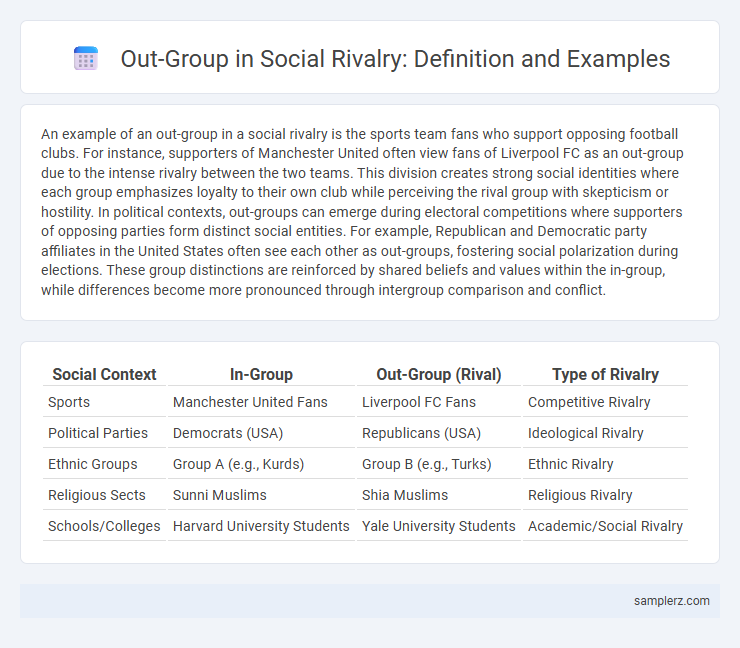An example of an out-group in a social rivalry is the sports team fans who support opposing football clubs. For instance, supporters of Manchester United often view fans of Liverpool FC as an out-group due to the intense rivalry between the two teams. This division creates strong social identities where each group emphasizes loyalty to their own club while perceiving the rival group with skepticism or hostility. In political contexts, out-groups can emerge during electoral competitions where supporters of opposing parties form distinct social entities. For example, Republican and Democratic party affiliates in the United States often see each other as out-groups, fostering social polarization during elections. These group distinctions are reinforced by shared beliefs and values within the in-group, while differences become more pronounced through intergroup comparison and conflict.
Table of Comparison
| Social Context | In-Group | Out-Group (Rival) | Type of Rivalry |
|---|---|---|---|
| Sports | Manchester United Fans | Liverpool FC Fans | Competitive Rivalry |
| Political Parties | Democrats (USA) | Republicans (USA) | Ideological Rivalry |
| Ethnic Groups | Group A (e.g., Kurds) | Group B (e.g., Turks) | Ethnic Rivalry |
| Religious Sects | Sunni Muslims | Shia Muslims | Religious Rivalry |
| Schools/Colleges | Harvard University Students | Yale University Students | Academic/Social Rivalry |
Defining Out-Groups in Social Rivalries
Out-groups in social rivalries often consist of competitors perceived as threats to a group's identity or status, such as sports fans opposing a rival team or political factions contesting power. These out-groups are characterized by distinct social markers, shared values, or opposing goals that reinforce separation and competition. Understanding the dynamics of social rivalries requires analyzing how in-groups define themselves through contrast with their out-groups, solidifying group cohesion and collective identity.
Classic Examples of Out-Groups in Sports Rivalries
Classic examples of out-groups in sports rivalries include the fans and players of the New York Yankees when viewed by Boston Red Sox supporters. In the intense rivalry between FC Barcelona and Real Madrid, each team's supporters often perceive the opposing club as the quintessential out-group. The Chicago Cubs and St. Louis Cardinals rivalry exemplifies how regional loyalty transforms opposing fans into distinct out-groups defined by identity and competition.
Political Out-Groups: Rival Parties and Their Effects
Political out-groups such as rival parties play a crucial role in shaping societal dynamics by reinforcing in-group identity and polarization. Members increasingly perceive opposing political parties as threats, leading to social division and reduced cooperation across ideological lines. This rivalry often results in heightened partisan animosity, influencing voter behavior and policy-making processes.
Out-Groups in Academic Competitions
Out-groups in academic competitions often consist of rival schools or teams perceived as direct competitors rather than colleagues. These groups are characterized by distinct identities and limited social interaction with the in-group, which fosters a competitive environment. Such divisions can influence students' motivation, leading to heightened group loyalty and sometimes intergroup bias.
Social Media Communities as Rival Out-Groups
Social media communities often perceive rival groups as out-groups, intensifying identity and loyalty among members through shared content and language. These rival out-groups, such as competing fandoms or political factions on platforms like Twitter and Reddit, frequently engage in conflicts that reinforce in-group cohesion and amplify polarization. The rivalry dynamics are driven by algorithms promoting engagement, which can escalate hostility and deepen social divides within digital spaces.
Cultural and Ethnic Out-Groups in Historical Rivalries
Historical rivalries often exemplify cultural and ethnic out-groups, such as the long-standing conflict between the Hutus and Tutsis in Rwanda, where ethnic divisions fueled violent confrontations. Another example includes the rivalry between the Serbs and Croats in the Balkans, marked by deep-rooted cultural and religious differences. These conflicts highlight how ethnic identities and cultural distinctions can intensify social divisions and perpetuate ongoing hostilities.
Workplace Rivalries: Departments as Out-Groups
Workplace rivalries often arise when departments perceive each other as distinct out-groups, leading to competition over resources, recognition, and influence. For example, marketing teams may view sales departments as rivals due to conflicting goals and differing performance metrics, fostering an "us versus them" mentality. Such interdepartmental tensions can undermine collaboration and reduce overall organizational efficiency.
Nationalism and the Creation of Out-Groups
Nationalism often fosters strong in-group identities by emphasizing shared culture, language, and history, which leads to the creation of out-groups perceived as threats to national unity or purity. Rival groups, such as ethnic minorities or immigrant populations, are frequently labeled as outsiders, reinforcing social exclusion and intergroup conflict. This dynamic intensifies societal divisions and can escalate tensions between the dominant national group and those considered outsiders.
Out-Groups in Youth Subcultures and Cliques
Out-groups in youth subcultures often manifest through rivalries between cliques like goths and jocks, where each group reinforces its identity by distinguishing itself from the other. These out-groups are characterized by opposing values, fashion, and behaviors that intensify social boundaries and group cohesion. Research shows that rivalry-driven out-groups contribute to stronger in-group solidarity but can also increase social tension within school environments.
Psychological Impact of Rival Out-Groups on Social Identity
Rival out-groups can significantly threaten social identity by fueling negative stereotypes and increasing in-group cohesion through perceived external threats. This psychological impact causes heightened prejudice, anxiety, and defensive behavior among in-group members, reinforcing social boundaries. Studies show that individuals facing rival out-group threats often experience diminished self-esteem and increased collective identity salience as a coping mechanism.

example of out-group in rival Infographic
 samplerz.com
samplerz.com